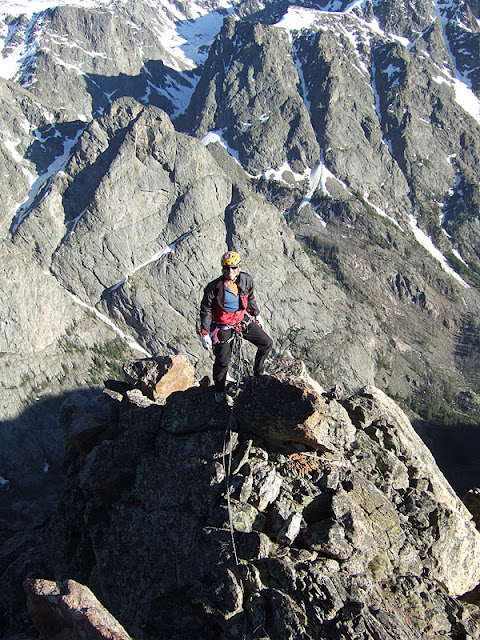
There were two previous routes on this wall. One follows the arete on the southern edge of the wall, the other follows a major dihedral system up the center. As we descended I noticed an intriguing system of ramps and cracks in between the two routes. It looked climbable but it was positioned such that it didn't see sun until 3 pm. I told Mark it would be like climbing on the dark side of the moon. We seriously doubted we could stay warm enough to climb it.
When we awoke early on day 2 we noticed the wind had stopped. It was all the encouragement we needed.
Mark Jenkins Photo.
Mark Jenkins Photo.
Roping Up
Mark Jenkins Photo.
Mark Jenkins Photo.
The first few pitches were easy and went quickly. It was nice to cover ground and establish ourselves on the wall.
Mark Jenkins Photo
Soon the Climbing Increased in Difficulty and our Upward Momentum Stalled
Mark Jenkins Photo.
Even Without the Wind we Froze. Trying to Warm the Fingers.
Mark Jenkins Photo.
Belay
Mark Jenkins Photo.
After 5 pitches of engaging climbing we found ourselves at a base of a large dihedral. The climbing above looked challenging and difficult to protect. We debated our options. A few challenging leads could take hours - too long if we hoped to finish the wall in one day. We needed a faster, easier option. We traversed right and hoped for the best.
The Traverse
Mark Jenkins Photo.
Mark Jenkins Photo.
Mark Jenkins Photo.
The traverse took some imagination and work to protect but Mark lead with confidence and skill. It was just as exciting to follow.
Our gamble paid off - we found ourselves at the base of a beautiful ramp/dihedral system on a massive ledge. We ate lunch and soaked in the scenery.
Our gamble paid off - we found ourselves at the base of a beautiful ramp/dihedral system on a massive ledge. We ate lunch and soaked in the scenery.
Lunch
Mark Jenkins Photo.
First pitch of the Ramp/Dihedral System
Mark Jenkins Photo.
Mark Belaying
After 3 pitches of 5.8-5.9+ climbing we were at the top of the ramp/dihedral system, the sun was finally upon us, and it was late in the afternoon. Climbing straight above looked difficult to protect and we weren't sure it would go. We had no choice but to follow the crack system. Mark lead a challenging 5.10 traverse pitch where the entire wall spilled beneath your feet. Even for a seasoned climber it was hard to fight back the vertigo.
First pitch of the Ramp/Dihedral System
Mark Jenkins Photo.
Mark Belaying
The ramp/dihedral system was incredible climbing. Featured granite, good protection, and a commanding position over an ocean of vertical space. The wall steepened as we climbed higher and the exposure was intimidating as we hung from belays over 1,000 feet off the ground.
Mark Jenkins Photo.
Mark Jenkins Photo.
After 3 pitches of 5.8-5.9+ climbing we were at the top of the ramp/dihedral system, the sun was finally upon us, and it was late in the afternoon. Climbing straight above looked difficult to protect and we weren't sure it would go. We had no choice but to follow the crack system. Mark lead a challenging 5.10 traverse pitch where the entire wall spilled beneath your feet. Even for a seasoned climber it was hard to fight back the vertigo.
Mark Leading the Traverse
The crack ended just before reaching the dihedral system to our left. We climbed to its end and then lowered about 20 feet into the next large dihedral system. We were far past the point of retreat, all our cards were on the table. We climbed out and up - hoping the find the final piece that would solve the puzzle.
The View Below
Mark Jenkins Photo.
Our intuition paid off. We reached a beautiful crack system that offered easy, fun climbing. The fatigue of climbing all day was setting in but we made quick work of the final pitches.
Mark Nearing the Top
On Top
Happy to Be Starting the Descent in the Daylight
Mark Jenkins Photo.
Descending
Mark Jenkins Photo.
Fremont peak consists of big walls and lots of scree. You can hike to the summit. We were happy to be able to walk back to camp without any rappels.
Celebrating Sucess
Mark Jenkins Photo.
In my mind there is nothing better than a dip in a ice cold alpine lake after climbing all day. Even though we froze all day I couldn't resist the temptation.
We made it back to camp just before dark. Happy to have accomplished this . . .
Dark Side of the Moon. IV 5.10. 12 Pitches













































